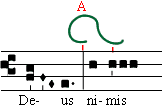
| THE
RYTHM OF GREGORIAN CHANT |
|
THE CHIRONOMY |
|||||||||||||||||||||||
|
By Chironomy is the conductor's gestures of the hands in order to show the rhythmic elements of the musical work and their different shades; the purpose of Chironomy is to achieve the most perfect interpretation. The chironomy of gregorian chant is based on the indication of the compound times as they are those that allow to perceive with more clarity the pulsations of the rhythmic movement. (1) The two fundamental movements are those that describe the arsis and the theses. The arsis is represented by an upward curved movement from left to right, and its beginning coincides exactly with that of the compound time.
The succession of compound arsic times is meant by upward undulant movements in spire:
The thesis is represented with a descending curved movement from left to right. The inferior part of the curve coincides with the beginning of the compound time.
The succession of compound thetic times is meant by descending undulant movements:
The movements are combined according to the requirements of the form of the rhythms:
When the piece begins with a simple arsic time, the simple time of elision serves as a preventive movement, either that the following time be arsic or thetic.
When the piece begins directly with a compound time, the time made up of elision serves as a preventive descending movement when the first compound time is arsic, and upward when the first compound time is thetic:
When a dividing great line is part of an arsic compound time, she is constituted in the beginning of the upward circular movement:
When a dividing great line is part of a compound thetic time, and the following period begins with a compound arsic, the dividing line can be taken as a preventive simple time of that compound arsic time.
If the period that follows the dividing line begins with a compound thetic time, the dividing line can be considered as a preventive simple time of that thetic compound time, with an upward wave:
The chironomy which is based on elementary rhythms has two fundamental movements: an upward right movement for the arsis and a descending right movement for the thesis, represented graphically in pyramidal form, so the beginning of the arsis coincides with the peak:
There are some cases in which the employment of this resource possesses great effectiveness: a. - In the succession of paroxytonic words, when the music coincides with the accentuation of the words, that is to say, high sound for the syllable of tonic accent, and low sound for the final syllable. The chironomy enhances the effect of this coincidence.
b. - In the clivis and other neumes succession when, exceptionally, the episema is not in the first sound of the neume. The chironomy enhances the contrast effect between arsic high sounds and thetic low sounds.
c. - In the cases of elementary rhythms with two simple times as arsis, the chironomy can highlight the effect of that rhythmic disposition. The arsis bends it means with ascending curve after the simple thetic time that is marked with adjusted horizontal movement to the duration of that simple time:
There are occasions in which it is possible to mark simple times, if some expression factor or uniformity is required, using the modern way of beating times.
CHIRONOMIC DESCRIPTION
Chironomy that includes marking for
elementary rhythms, ___________ (1) JUSTINE WARD. Canto gregoriano, p. 41, Nestlé & ci., Rome, 1938. BIBLIOGRAPHY JACHINO, CARLO. Ritmo musical. Enciclopedia Italiana, Vol. XXIX. LIBER USUALIS MISAE ET OFFICII. Desclée & Socii, Bélgica, 1956. All examples have been taken in here. MARTÍNEZ SOQUES, FERNANDO, Sch. P. Método de canto gregoriano. Ed. Pedagógica, Barcelona, 1952. RIEMANN HUGO. Composición musical. Ed. Labor, Barcelona, 1923. RIEMANN, H. Fraseo musical. Ed. Labor, Barcelona, 1928. RIEMANN, H. Teoría general de la música. Ed. Labor, Barcelona, 1945. SUÑOL, GREGORIO MARIA, O.S.B. Método completo de Canto gregoriano, 9ª. Ed., Monasterio de Monserrat, 1952. WARD, JUSTINE. Canto gregoriano. Desclée & Ci., Roma, 1938. ©
Reproduction in whole or in part is prohibited without the author's
expressed authorization. |
![]()
Theory
and Technic | Canticum
Novum | Didactic
Concerts |
Links
History | Characteristics
| Notation | Modes
| Rhythm | Chironomy
| The psalmody |
| Latin pronuntiation |
Translations & scores|
Bogotá/Colombia - 2002





























